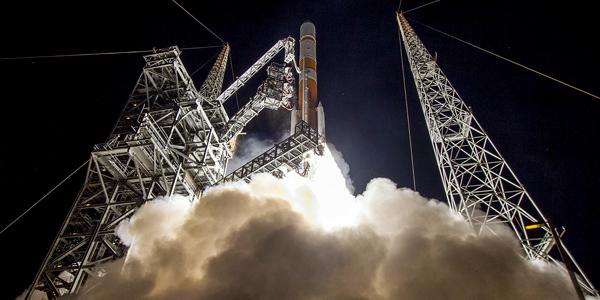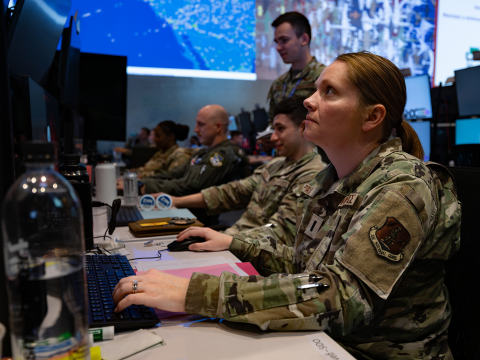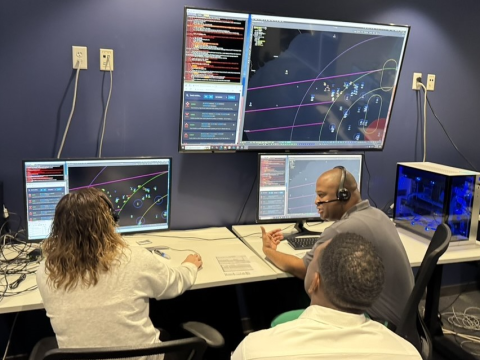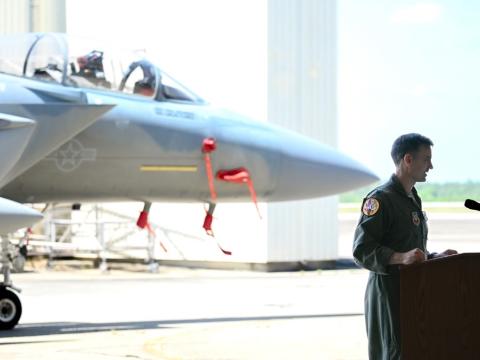An Insecure Space
While space has been a contested domain from the beginning—from the first trial of an anti-satellite weapon in 1959—what has changed is the United State’s confidence in being able to deter attacks, according to several officials who testified recently about U.S. space warfare readiness before the U.S. House of Representatives Committee on Armed Services. The space domain is more complex and more is at stake, the experts told Congress.
“"Today’s military commanders are facing serious threats in a space domain that is increasingly congested, contested and competitive," said Gen. Robert Kehler, USAF (Ret.), former commander, U.S. Strategic Command.
Furthermore, the growing dependence on space for terrestrial systems leaves the United States—and its allies–vulnerable, the experts stressed. The U.S.’ national security space systems are not only used for combat operations but also for counterterrorism operations and peacetime efforts. So losing dominance in space would not only degrade space capabilities, but also the nation’s traditional terrestrial capabilities in the land, sea and air domains, said Douglas Loverro, former DOD deputy assistant secretary of defense for space policy.
"Space systems give the U.S. military global reach, power and influence, but our dependence on space across the full spectrum of conflict creates a vulnerability, as the space systems are not adequately protected," said Todd Harrison, director, Aerospace Security Project, Center for Strategic and International Studies.
Gen. Kehler added that while there may be lessons to be applied from the Cold War era in regards to space dominance, today’s problems are far more complex and could have a potentially far greater impact. "Given our dependence and that of our allies and partners on space, the loss of critical assets today could prove decisive to our ability to successfully prosecute a military campaign," Gen. Kehler said.
To Loverro, "unfortunately, the answer is 'no,'" as to whether or not the United States’ space warfare is ready. "We are not ready, or more properly, we are not on a firm path to be ready," he added.
Notably, U.S. adversaries seem almost ready to capitalize on our vulnerabilities, the experts warned.
"Our adversaries have moved aggressively to field forces that can challenge our space capabilities from the ground, through cyberspace, and in space," Gen. Kehler said. They are harnessing simple and widely available and affordable GPS jammers as well as highly sophisticated anti‐satellite weapons. China and Russia are already working on anti-satellite weapons, which they will soon bring to fruition, Loverro noted. As such, the United States "must make certain that our space forces can withstand such an onslaught."
For Gen. Kehler, this involves the United States planning and conducting complex operations in space that involve joint, interagency and allied capabilities and forces.
The National Security Strategy, with its focus on responses to attacks, and the National Space Policy, with its focus on withstanding attacks, both provide a policy backdrop, according to Loverro. However, leaders in the Executive and Legislative Branches "must align on a cogent, comprehensive plan of action as well as the ends, ways and means to implement that action plan," Gen. Kehler recommended.
All of the experts testifying called for organizational shifts in the Air Force to address space warfare readiness. Loverro wants to see an organization either within or outside of the Air Force dedicated to assuring U.S. space warfighting readiness—given that the gap in capabilities, in his opinion, extends from more than normal bureaucratic inefficiencies.
“The ability of our space leaders to understand the strategy of space deterrence and space warfighting, and how to address those issues directly by understanding all the tools at their disposal, results from our ability to grow space-smart leaders who can think and act in response to long-term and short-term changes and challenges to the domain,” Loverro said.
“It is not enough to have two or three senior leaders such as Gen. Hyten or Gen. Raymond or Gen. Kehler who understand the issue. It must be understood at the captain, major, lieutenant colonel and colonel level. It must be something the entire force comprehends as they go about their daily job of defining requirements for the next generation system, exercising those capabilities in flag-like exercises, conceiving of the next elements of a resilient architecture or driving doctrinal alternatives that eventually change the way we fight,” he stressed.
Meanwhile, the general suggested that commanders must achieve a common understanding of space-related authorities, “vertically across organizations and horizontally across mission partner organizations,” in order to reach a unity of effort.
“It is also important to ensure space operational authorities are ‘normalized,’ so space forces are fully integrated into the joint force with appropriate rules of engagement,” he added. To that end, the military must clarify the relationships and responsibilities between the commander of U.S. Strategic Command and other U.S. government space operators, especially once hostilities in space are imminent or underway, Gen. Kehler said.
Harrison cautioned that the military must carefully balance its needs, certainly a challenge in the midst of a commercial space revolution. At a minimum, the United States should figure out how attacks on the systems owned by commercial satellite service providers would be handled.
Additionally, the military must stay attuned to the commercial advances so that it can leverage, wherever possible, the technology, systems and services created by the sector, Harrison offered. He lamented that it may be difficult to understand advances in commercial space technology “if military acquisition officers are rotating into the space program with little if any prior space experience,” Harrison said. He also called for the creation within the Air Force of “a dedicated cadre of space acquisition professionals, both civilians and uniformed military, that are managed separately from the rest of the Air Force acquisition workforce.”
"It is clear that it requires a separate career path than that of its parent service," Loverro stated. "Whether that is under a separate service, a Marine Corps like structure or an Army Air Corps structure, is argumentative and beyond the scope of this particular hearing. But if we are to address the problems discussed above, if we are truly to embrace space warfighting readiness, we must address the personnel issue above all else."





Comments